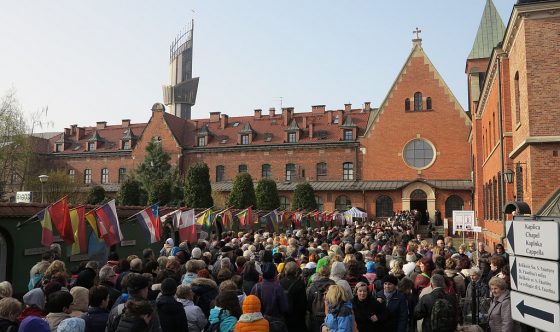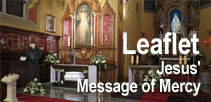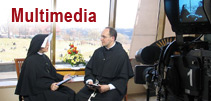The charism of Saint Faustina yielded not only the new school of spirituality but also the Apostolic Movement of the Divine Mercy. It undertakes in different manners her task of proclaiming to the world the message of Mercy through the testimony of life, deeds, words and prayer.
The idea of this Movement was revealed to Sister Faustina in Vilnius in 1935 when the Lord Jesus ordered her to set up a new congregation “to preach Divine mercy to the world and to pray for Divine mercy for the world” (Diary 436) Initially she claimed that she had to leave her congregation and set up a contemplative convent for which she wrote even a summary of convent rule. Gradually she recognized that the idea went far beyond one convent or congregation. In the beginning of 1936, she wrote in a letter to her spiritual director Rev. Michał Sopoćko, “I can see clearly that there is going to be not only both a female and male congregation, but a great association of lay people which everybody can be a member of and thereby with his deeds remind others about God’s mercy and exercise mercy towards others. Please do not think that these thoughts are [mere] madness, for they are the sincere truth, which will shortly be carried out in deed, even if I would have no one in favour of this work; still, I am not discouraged by anything, for it is enough for me to know that this is the will of God.” However she still claimed that her role in this work would be setting up a contemplative congregation. The desire of fulfilling of this task was the basis for passive nights (mind and will) in her life, after which she achieved full union with God: mystical betrothal and mystical marriage. Finally in her mystical experience she clearly recognized that the task, albeit one, would have three aspects. The first was that of cloistered religious orders, “is for those souls who will be isolated off from the world, burn as a sacrifice before God’s throne, and beg for mercy upon the whole world… And pray for blessings on priests, and by their prayers they will be preparing the world for Jesus’ final coming” (Diary 1155). The second aspect was that the religious congregations were to combine prayer with acts of mercy “and in a world full of egoism they will endeavour to kindle the love and mercy of Jesus” (Diary 1156). The third aspect consisted in the fact that everyone in the world can belong to this group through prayer and deeds of mercy without any obligation to take vows. “A member of this colour – Sister Faustina wrote – should do at least one act of mercy a day, though they can do more, since anyone, every the poorest, can do an act of mercy, it’s easy” (Diary 1158).
The Circumstances in which the Apostolic Movement
of the Divine Mercy had originated
God through the charism and the mystical experience of Saint Faustina inspires the realization of the mission of proclaiming the message of Mercy in the Church, through the work of the Apostolic Movement of the Divine Mercy. The idea of this work was not at once clearly revealed to her, but grew slowly, passing different phases of development from setting up the new contempla- tive order until the determination of the structure’s movement which is formed by the cloistered religious orders, active congregations and people living in the world.
The beginnings of this idea go back to the year 1935. At that time, Sister Faustina had lived in the home of the Congregation in Vilnius. She had enjoyed the grace of contemplation, and of profound life with God; she had already partly fulfilled the wishes of the Lord Jesus, as His image had already been painted and on the first Sunday after Easter, on April 26-28, 1935 was publicly displayed and worshipped in Ostra Brama. Yet her joy was marred by the foreboding of the immensity of God’s new tasks for her. “I was frightened by their magnitude – she recorded in her Diary – and felt absolutely incapable of carrying them out” (Diary 429). It was then that she heard the words of the Lord Jesus, “ «You shall prepare the world for My final coming». I was shaken to the core by these words – she writes further on in her spiritual diary – and even though I pretended that I hadn’t heard them, I understood them perfectly well, of that I am in no doubt whatsoever”(Diary 429).
On the Day of the Pentecost, on June 9, 1935 she had heard next order, this time in the form of a concrete task, “You and your companions shall beg for mercy for yourselves and for the world” (Diary 435). By fulfilling the charism of the Congregation, Sister Faustina had up until then mainly taken care of the young girls and women who were in need of deep moral revival; it is not surprising therefore that she understood the above words of the Lord Jesus as an order to set up a new congregation whose goal it would be to entreat God’s mercy for the whole world.
As she was not at all sure if she had interpreted the Lord’s intention correctly, and she received no explicit order to inform her confessor about this issue, she decided not reveal the Lord Jesus’ wish to anyone for twenty days. It was only on June 29 when provoked by her confessor, Rev. Michał Sopoćko, she decided to reveal the secret to him. “The secret is this – she wrote in her Diary – God wants a congregation to preach Divine mercy to the world and to pray for Divine mercy for the world” (Diary 436). During this conversation, the Lord Jesus who stood on the threshold of Sister Faustina’s room, as He is represented in the image, and He reassured her saying, “I want such a congregation” (Diary 437). Sister Faustina felt incapable of fulfilling the above task and that is why she defended herself against accepting it, “But strangely enough, Jesus paid no attention to my cries – she wrote in her Diary – but granted me light and the understanding how pleased He was with this work; He paid no attention to my weakness but let me know how many difficulties I would have to overcome” (Diary 437).
On the day following the conversation with Rev. Michał Sopoćko, i.e. on June 30, 1935, during Holy Mass, Sister Faustina had once again seen the Lord Jesus who told her that He desired “a congregation founded as soon as possible” (Diary 438); He then defined its spirit which was to be modeled on Him “from the manger to My death on the cross” and said that the main task of the new Congregation was to proclaim the mercy of God and entreat it for the whole world (Diary 438). After receiving Holy Communion, Sister Faustina experienced in a mystical way the presence and blessing of the Holy Trinity, following which all previous fears, anxieties, weaknesses and helplessness in the face of the new task had disappeared. “When I came to myself, I felt I had the power and courage to do God’s will – she recorded in her Diary – nothing seemed difficult” (Diary 439).
Such were the circumstances in which the Apostolic Movement of the Divine Mercy was created. It is the Lord Jesus Himself who is its creator and initiator; it is Him who uncovers before His “secretary” His intention to create such a “congregation”, that is movement, whose members are to imitate Him “from the crib to His death on the Cross” as well as proclaim the mercy of God and entreat it for the whole world. In these first revelations, the Lord Jesus defined the fundamental traits of this task, its spirit as well as the character of apostolic involvement which He had placed in an eschatological perspective: namely, the need to prepare the world for His second coming.
The Development of the Idea
of the Apostolic Movement of the Divine Mercy
The shape of the new task as outlined in the above first revelations, was understood by Sister Faustina quite unequivocally: namely, as an order to set up a contemplative convent. Even the words of Saint Ignatius whom she had asked for help in fulfilling the will of God, and saying that “This rule can be applied to this Congregation as well” (Diary 448), did not manage to change her way of thinking. She continued to think that the intention here was to create a new convent which would be totally dedicated to the tasks the Lord Jesus had set up before her. At that time, she saw no possibility of realizing the above task within her own Congregation, nor in any other way.
At the end of November 1936, Sister Faustina had outlined a draft of the rules for the new contemplative convent whose the general layout of the order was based on the constitutions of her mother Congregation. In it, she included the demands of the Lord Jesus regarding the tasks and the spirit of the new congregation and she also tried to define what she regarded as the more important rules relating to: the selection of members, the stages of religious formation, prayer, penance, community life, apostleship and management. Already at the first reading of the above draft of the constitutions, one is struck by a certain radicalism which reveals itself in the policy concerning the selection of members, in the everyday practise of monastic life, based on prayer, in renouncement and severe penance, as well as in the ardent apostolic involvement in the task of salvation of souls.
In March 1936 Sister Faustina had left Vilnius and went first to Walendów, and then to Derdy, and Kraków. In April 1936, while still in Walendów, she had written to Rev. Michał Sopoćko, “I can see clearly that there is going to be not only both a female and male congregation, but a great association of lay people which everybody can be a member of and thereby with his deeds remind others about God’s mercy and exercise mercy towards others’. She continued to pray for this intention and look for new ways of fulfilling God’s will. She talked to her confessors and superiors, but above all she offered in this intention her immense sufferings during her passive nights of spirit. She had only wished for one thing, namely to get to know God’s intention as regards this plan and to acquit herself of everything the Lord God had expected from her.
In the end, under the date of June 27, 1937 she recorded that during Holy Mass, the Lord God had enlightened her and gave her profound understanding concerning this task and not a shadow of a doubt remained in her soul (cf. Diary 1154). This task is one, she recorded in her Diary, but, as it were in three aspects. The first is “souls who will be isolated off from the world, burn as a sacrifice before God’s throne, and beg for mercy upon the whole world… And pray for blessings on priests, and by their prayers they will be preparing the world for Jesus’ final coming” (Diary 1155). The second aspect was that the religious congregations were to combine prayer with acts of mercy. “In particular, they will protect the souls of children against evil. …and in a world full of egoism they will endeavour to kindle the love and mercy of Jesus” (Diary 1156). The third aspect – according to Sister Faustina – consisted in the fact “anyone alive on Earth may belong to this colour” (Diary 1157). A member of this group ought to perform at least one act of mercy a day, but “though they can do more, since anyone, every the poorest, can do an act of mercy, it’s easy” (Diary 1158).
It is only in the context of the thus understood plan, which is one, but in three aspects, that one fully explain the different conceptions regarding the localization of the future congregation which Sister Faustina envisaged. At one time, it was to be a small church and right next to it, a convent with twelve cells, where nuns were to live in seclusion (cf. Diary 563); at other times, a building in a state of disrepair without windows and doors (cf. Diary 559); in yet another vision, a small chapel in which Father Sopoćko was administering Holy Communion to six sisters (cf. Diary 613), and in the next, a convent which looked after children between five and eleven years of age, defending them against evil (cf. Diary 765). In another vision, Sister Faustina saw a convent in which everything was poor and very scanty, but the spirit was great (cf. Diary 892). In the last vision associated with this topic, Sister Faustina saw a convent whose rooms were large and spacious. “The persons living in that convent were still dressed like laypeople, but a fully religious spirit prevailed” (Diary 1154). This last vision had directly preceded the most complete description of this unique plan in which there participate contemplative convents, persons representing various institutions of consecrated life, as well as all others who through prayer and deed become involved in the work of mercy of the Lord Jesus.
In the Diary entry from June 27 1937, one finds the final comments relating to the idea of the Apostolic Movement of the Divine Mercy which in the sense given to it by the Lord Jesus was to be understood broadly – as a movement; whereas in the thought of Sister Faustina, it matured gradually, evolving from the concept of a cloistered contemplative convent, through active congregations, to the inclusion of lay persons into the above task.
Namely, one should draw attention to the fact that in the writings of Sister Faustina the word “movement” does not occur even once; instead, there appears the word “congregation” or “work”. The word “congregation” is used by both the Lord Jesus and Sister Faustina, yet each of tchem uses this word in a different sense. The majority of people, including Sister Faustina, understood the word “congregation” as a religious community. That is why, Christ’s words, “I want such a congregation” (Diary 437) or “a congregation founded as soon as possible” (Diary 438), were understood by Sister Faustina literally. She thought that the Lord Jesus wished that a congregation which would proclaim the mercy of God and entreat it for the world be created. Afterwards she wrote that to this congregation there should also belong people representing different vocations, women and men, and even all people living in this world. The above variety of vocations points out to a different sense of the word “congregation”, namely the biblical one which corresponds to the Hebrew term “qahal”; it was the latter term that the Lord Jesus had used in His conversation with Sister Faustina.
According to the Dictionary of Biblical Theology, the Hebrew word “qahal” denotes “congregation of people for religious purposes, in most cases for worship”. The above religious “congregation” may be characterized by means of the following constituent features:
The congregation owes its existence to a “summons” or “calling” together issued by God;
It gathers around a Tent of Meetings or a shrine out of conviction that God lives in its midst;
God reveals and expresses His will to the people who have gathered through theophany or else through an authorized representative;
The congregation gathers for religious purposes, to entreat God for graces or else to do penance and it is subject to successive sanctification by God.
One cannot fail to notice that all the constituent features of the biblical concept of “congregation” occur in the enunciations of the Lord Jesus, recorded in the Diary of Saint Faustina. Thus, the Apostolic Movement of the Divine Mercy as defined by the Lord Jesus, is as it were a newly summoned congregation, a new “calling” of the People of God who at this phase in history are to fulfill a goal set up by God as well as acquit themselves of certain precisely defined tasks, consisting in the revival of religious life, the proclamation of the mystery of the mercy of God and entreating it for the whole world. It is worth emphasizing at this point that these are precisely the tasks which the Holy Father John Paul II had set up before the whole Church in his encyclical Dives in Misericordia.
Attempts to Implement the Idea
of the Apostolic Movement of the Divine Mercy
An issue which was most important in the life of Sister Faustina was her determination to faithfully fulfill the will of God. She presented all the wishes of the Lord Jesus to her confessors and superiors, and then consistently strove to implement them, regardless of the difficulties, hardships and sufferings. Such was also the case with the realization of the idea of the Apostolic Movement of the Divine Mercy, which according to Sister Faustina consisted in setting up a new congregation; Sister Faustina felt obliged to carry out the above task even after she had become aware that task involved the participation of both male and female convents, as well as the creation of a great association of lay people. She thought that her role in the realization of the above task would consist precisely in setting up a contemplative convent which would be totally and unreservedly dedicated to the realization of the tasks set up by the Lord Jesus.
In September 1935, she presented the matter to the ordinary of the Vilnius diocese, Archbishop of Vilnius Romuald Jałbrzykowski; the latter came to the conclusion that Sister Faustina’s plan to leave her own Congregation was a serious interior temptation, whereas the task of entreating the mercy of God for the world and particularly for sinners should be realized in her own convent (Diary 473). “My daughter, arm yourself with great patience – the Archbishop told Sister Faustina – if these things are from God, then sooner or later they will come into effect” (Diary 473, 479).
In October 1935, Sister Faustina had left for Kraków to take part in an eight-day long retreat. During the retreat, she had an opportunity to discuss the matter with Father Józef Andrasz SI who assured her even before she had taken her perpetual vows that what she experienced within her soul, came from God. Also this time, the Cracovian confessor admitted that in the entire undertaking, he “dit not see any illusions or anything contrary to the faith; these things are all good in themselves, and indeed it would be a good thing if there were a group of souls praying for the world, for we all need prayer” (Diary 506), but at the same time, he advised Sister Faustina great caution, total reliance on her superiors and ardent prayer, so as to get a clearer conception of God’s plan for her (cf. Diary 506).
Father Michał Sopoćko who remained in Vilnius, had now become even more dedicated to the cause and had pleaded with Archbishop Romuald Jałbrzykowski to give permission to set up the new convent and to create suitable conditions for its creation. He recognized and advised her to work continuously on agreeing with God’s will and to do nothing without a precise permission of the Cracovian spiritual director of her soul, Father Józef Andrasz. Besides, he recommended to her that she should continue to listen to the voice of God, take great care and act with caution, “despite the great inner urgency to act quickly”. When assessing his own efforts and attempts, he admitted quite frankly, “At the moment, I cannot see any progress as regards the creation of conditions that would be propitious for the setting up of the new congregation, but I do not lose hope and I continue to do what I can in this matter.”
Sister Faustina also did what was in her might to realize her vision. She talked to Mother General as well as to the Cracovian Mother Superior from whom she obtained permission to act, contact and correspond with the outside world. She talked a lot about it to Father Józef Andrasz, from whom she expected concrete decisions. Taking advantage of Mother General Michaela Moraczewska’s visit to the Kraków House at the beginning of May 1937, Sister Faustina asked her to be released from the Congregation. Earlier on, Mother General did not want to give permission to it, fearing that it might be some delusion Sister Faustina had indulged in. She asked God for a sign thanks to which she could recognize that this decision is in accord with His will. She thought that the idea itself was great and beautiful, yet Sister Faustina’s role in it, should be likened to a hidden spring, which meant that she did not necessarily have to abandon the Congregation. Thus when on May 4, 1937 Sister Faustina talked to Mother General about her decision to leave the convent, she had heard the following words, “Up to now, I have always held you back, but now I leave it entirely up to you; if you want to leave, you can do so; if you want to stay in the Congregation, you can stay” (Diary 1115). Sister Faustina decided that this time she would leave the Congregation and that she would immediately write to the Holy Father and request him to release her from her vows; she would then leave for Vilnius so as to set up a new congregation. However, the minute she had left the room, darkness had once again descended upon her soul. “It’s strange that every time I ask for permission to leave, my soul is overcome with darkness, and I feel I’m left completely on my own. When I was in this state of spiritual distress, I decided to go back to Mother and tell her about my strange distress and struggle. She replied, «The idea of you leaving is a temptation»” (Diary 1115), and Sister Faustina’s confessor concluded that “maybe it was not yet the time God had appointed. “You must pray and wait patiently” (Diary 1117).
After this last attempt to leave the Congregation, Sister Faustina wrote, “No one would be able to understand all the suffering and anguish I’m going through; neither am I able to describe it, nor can there be any greater suffering. The suffering martyrs go through is no greater, for at such times death would bring me relief; there is nothing I can compare this suffering with, this endless dying of the soul” (Diary 1116).
In spite of so many difficulties and setbacks, Sister Faustina was nevertheless deeply convinced that it was clearly God’s will that the new congregation should be created. She knew that “God, in His unfathomable judgements, sometimes suffers those who put in the greatest effort into one of His works to be deprived of the fruits of their labour here on Earth; He keeps all their enjoyment for eternity” (Diary 1402). She wrote to Father Sopoćko that God is pleased with what has already been done in this matter. “The difficulties and protests are only a passing phase …, and they never constitute a proof that this undertaking is not pleasing to God.” Having disappeared from public view she did not undertake any further actions; she was also aware of the fact that through her God had initiated His plan. In her last letter to her Vilnius confessor and spiritual leader, Sister Faustina wrote, “As regards …the new congregation, there is not a shadow of a doubt in my mind that it is God’s explicit intention that such a congregation should be set up. God had used us to initiate His work and it is not our task to probe into the issue of who will eventually complete it; whereas we should do all that is in our power right now, nothing more.”
The painful cleansings of the “dark nights of the spirit” accompanied the realization of this idea. They led Sister Faustina to the heights of mysticism and allowed, on spiritual ground, to realize the establishment of the Apostolic Movement of the Divine Mercy in order to lay foundations of the constitution of this work in the Church. Thus, the Lord Jesus did not really wish for Sister Faustina to set up a new congregation, if in spite of her numerous efforts and her striving to fulfill God’s will, He did not after all permit it. What the Lord Jesus really did want to achieve was to form a perfect model to be followed by all apostles of the Divine Mercy; He wanted to create a model of infinite trust in God and of mercy toward others, a model of proclaiming the mystery of God’s mercy for the world through one’s life and word and of entreating it for the world. The above conclusion also seems to be confirmed by the fact that having courageously borne the sufferings associated with the spiritual dark nights, when in 1938 on the day of the Feast of Mercy, she had received the grace of complete freedom of the spirit and had outlined the final structure of the new undertaking, she had never taken up the issue again. She was dying in the conviction of having acquitted herself well of her duties and obligations. During her last conversation with her Vilnius confessor which took place a few weeks before her death, she had informed him that he should primarily be interested in the spread of the cult of the Divine Mercy, and should not worry too much about the issue of the new congregation, as “it will soon be known who should do what in this matter.”
The full text in the book of Sr. M. Elizabeth Siepak ISMM, The New Congregation of Sister Faustina. The Apostolic Movement of the Divine Mercy, Kraków 2002.; [Nowe „zgromadzenie” św. Siostry Faustyny. Apostolski Ruch Bożego Miłosierdzia, Kraków 2002.]
Prepared by Sr.M.Diana Kuczek ISMM
















